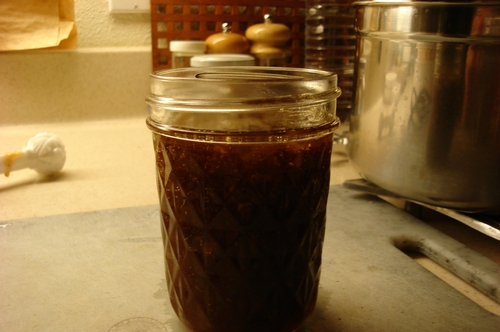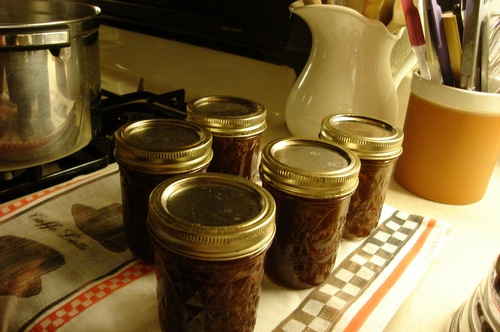
University of California
Cooperative Extension Ventura County
Preserving summer's bounty
As we move through the summer months, backyard gardeners everywhere are faced with the questions, "What do I do with all of these [insert vegetable or fruit here]?" followed by, "What was I thinking last spring when I planted all of this?"
To the rescue is a series of free, downloadable publications from the ANR Catalog. I've always noticed that these publications move to the top of our download charts each summer, so this year I decided to try one of the recipes.
This comes from the category, "What do I do with all of these peppers?" and is actually called Peppers: Safe Methods to Store, Preserve, and Enjoy. I had some dried apricots in the pantry, so I opted for the Apricot Pepper Jelly.
The ingredients are simple enough, dried apricots, peppers, apple cider vinegar, sugar and pectin.

A lot of people think making jam is complicated and requires special equipment. It's actually quite easy. If you can read and follow directions, and have good attention to keeping things clean, making preserves is a snap. The only piece of special equipment I have purchased for canning is a jar lifter. And of course you need the jars, lids and bands. Note that while the jars and bands can be used over and over, you cannot safely re-use the lids.

I wanted my jelly to have a little extra kick, so I substituted habanero for the jalapeño called for in the recipe.
When handling hot peppers, always wear rubber gloves!

After soaking the dried apricots in hot water, they are drained, then added with the peppers and the vinegar to a food processor.

This looks like it needs a couple more pulses.
Then into the saucepan it goes, along with the sugar and pectin as directed. The recipe calls for food coloring, but since that is only for appearance, I left it out.
Less than 10 minutes later, the mixture is ready to ladle into sterilized jars.

Purists probably would not call this a jelly, as it contains small bits of the apricots and peppers.
Once all the jars are filled and capped, into the waterbath they go. The recipe contains a chart of processing times based on altitude; mine is a short 10 minutes.

After the proper processing time, lift the jars out of the waterbath. Handle them carefully with the jar lifter, as they are very hot. After a few minutes out of the hot water, you will hear the ping! ping! ping! of success as the vacuum seal is made.

An initial taste test before processing revealed a piquant flavor, so I'm going to let the flavors settle in and mellow for a couple of weeks before use. I think it will taste great with goat cheese on crackers as an appetizer, or as a glaze on baked chicken.
Also in this series are similar publications for tomatoes, cantaloupe, strawberries, garlic, oranges and apples.
To the rescue is a series of free, downloadable publications from the ANR Catalog. I've always noticed that these publications move to the top of our download charts each summer, so this year I decided to try one of the recipes.
This comes from the category, "What do I do with all of these peppers?" and is actually called Peppers: Safe Methods to Store, Preserve, and Enjoy. I had some dried apricots in the pantry, so I opted for the Apricot Pepper Jelly.
The ingredients are simple enough, dried apricots, peppers, apple cider vinegar, sugar and pectin.

A lot of people think making jam is complicated and requires special equipment. It's actually quite easy. If you can read and follow directions, and have good attention to keeping things clean, making preserves is a snap. The only piece of special equipment I have purchased for canning is a jar lifter. And of course you need the jars, lids and bands. Note that while the jars and bands can be used over and over, you cannot safely re-use the lids.

I wanted my jelly to have a little extra kick, so I substituted habanero for the jalapeño called for in the recipe.
When handling hot peppers, always wear rubber gloves!

After soaking the dried apricots in hot water, they are drained, then added with the peppers and the vinegar to a food processor.

This looks like it needs a couple more pulses.
Then into the saucepan it goes, along with the sugar and pectin as directed. The recipe calls for food coloring, but since that is only for appearance, I left it out.
Less than 10 minutes later, the mixture is ready to ladle into sterilized jars.

Purists probably would not call this a jelly, as it contains small bits of the apricots and peppers.
Once all the jars are filled and capped, into the waterbath they go. The recipe contains a chart of processing times based on altitude; mine is a short 10 minutes.

After the proper processing time, lift the jars out of the waterbath. Handle them carefully with the jar lifter, as they are very hot. After a few minutes out of the hot water, you will hear the ping! ping! ping! of success as the vacuum seal is made.

An initial taste test before processing revealed a piquant flavor, so I'm going to let the flavors settle in and mellow for a couple of weeks before use. I think it will taste great with goat cheese on crackers as an appetizer, or as a glaze on baked chicken.
Also in this series are similar publications for tomatoes, cantaloupe, strawberries, garlic, oranges and apples.
